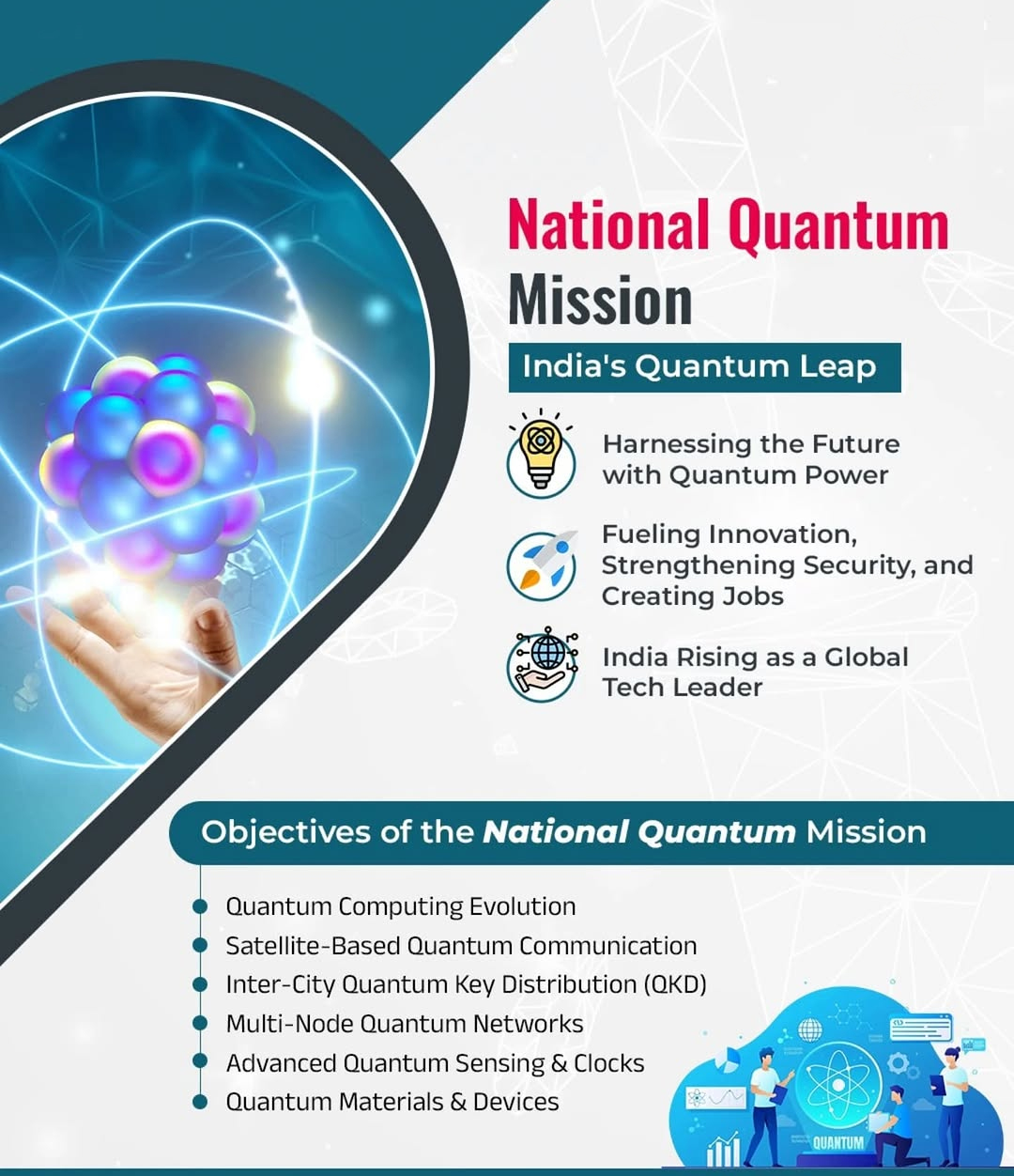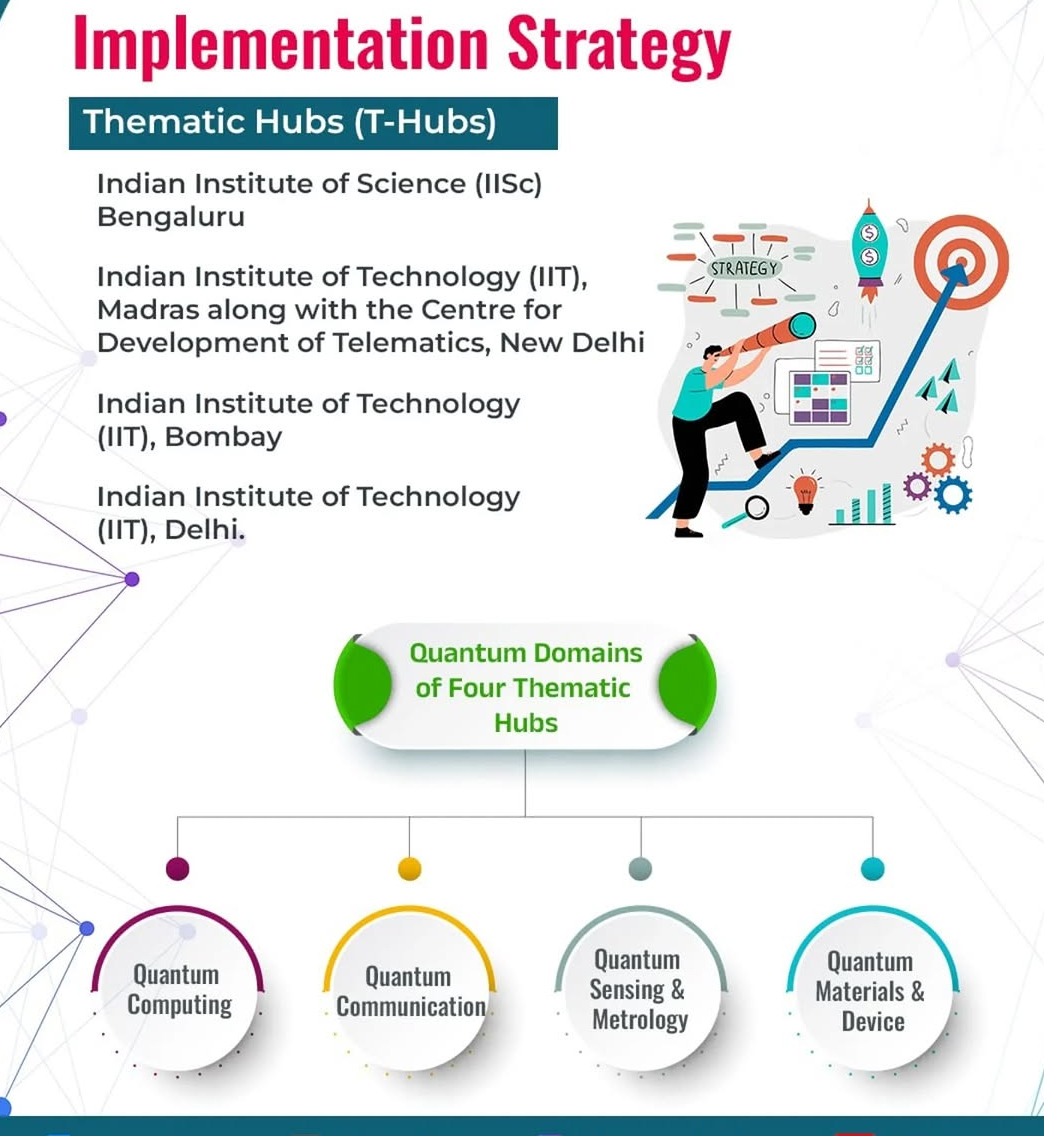Introduction:
India has taken a significant step towards building quantum-resilient cybersecurity through two major developments. First, Indian scientists have successfully developed and certified a quantum technique for generating true random numbers — a process essential to the foundation of digital encryption. Second, the Government of India has released a whitepaper titled “Transitioning to Quantum Cyber Readiness”, outlining the policy roadmap for adapting to the disruptive impact of quantum computing.
-
- Together, these initiatives reflect India’s growing capability in quantum science, digital security, and strategic technology governance, areas that will shape the nation’s digital sovereignty in the coming decade.
- Together, these initiatives reflect India’s growing capability in quantum science, digital security, and strategic technology governance, areas that will shape the nation’s digital sovereignty in the coming decade.
Importance of Random Numbers in Modern Encryption:
-
- Random numbers are the invisible building blocks of digital security. Every encrypted password, bank transaction, and secure communication depends on randomly generated numbers to create encryption keys. These keys are meant to be unpredictable, ensuring that even powerful computers cannot reverse-engineer them.
- However, most digital systems today rely on pseudorandom numbers, which are generated through algorithms rather than through truly random physical processes. While these numbers appear random, they are ultimately derived from a mathematical sequence, meaning they could, in theory, be reconstructed if the algorithm and its initial input values were known.
- Such pseudorandom systems have served well in the classical computing era. But with the advent of quantum computing, which can perform vast calculations at speeds unachievable by traditional machines, these encryption systems face a serious risk of becoming obsolete.
- Random numbers are the invisible building blocks of digital security. Every encrypted password, bank transaction, and secure communication depends on randomly generated numbers to create encryption keys. These keys are meant to be unpredictable, ensuring that even powerful computers cannot reverse-engineer them.
The Scientific Challenge: Achieving True Randomness:
-
- In the natural world, randomness exists in processes that are fundamentally unpredictable — such as radioactive decay or the behaviour of subatomic particles. In the quantum realm, particles like photons and electrons exist in superposition, meaning they can occupy multiple states simultaneously. When measured, they randomly “choose” a definite state.
- This property forms the basis of the Quantum Random Number Generator (QRNG). By assigning numerical values (‘0’ or ‘1’) to the random outcomes of quantum measurements, scientists can generate sequences of numbers that are genuinely unpredictable.
- However, a critical challenge has been certification — determining whether the randomness is indeed quantum in origin, or a result of technical noise, faulty devices, or external manipulation. A random sequence is only as trustworthy as its source. Ensuring device-independent verification of randomness, therefore, has been one of the most complex problems in quantum information science.
- In the natural world, randomness exists in processes that are fundamentally unpredictable — such as radioactive decay or the behaviour of subatomic particles. In the quantum realm, particles like photons and electrons exist in superposition, meaning they can occupy multiple states simultaneously. When measured, they randomly “choose” a definite state.
India’s Breakthrough: Device-Independent Quantum Randomness:
-
- In a major achievement, Indian researchers have experimentally demonstrated device-independent quantum random number generation using a general-purpose quantum computer. This represents a global first in the certification of randomness in non-laboratory, real-world conditions.
- Traditional approaches to such experiments relied on entangled quantum particles separated by hundreds of metres to eliminate interference — an arrangement unsuitable for practical deployment. The Indian team, however, introduced a novel concept: instead of using spatial separation, they employed time separation within a single quantum particle to test violations of the Leggett–Garg inequality, a principle used to confirm the quantum nature of randomness.
- By observing this violation, they proved that the randomness originated from genuine quantum phenomena rather than experimental imperfections. Crucially, the experiment was conducted on a commercially available quantum computer, demonstrating that the technique can function under realistic conditions with inherent noise and disturbances.
- This breakthrough marks a decisive transition from theoretical exploration to applied quantum technology, opening pathways for commercially deployable quantum-secure systems.
- In a major achievement, Indian researchers have experimentally demonstrated device-independent quantum random number generation using a general-purpose quantum computer. This represents a global first in the certification of randomness in non-laboratory, real-world conditions.
Implications of the Discovery:
This scientific advancement carries both technological and strategic implications:
1. Quantum-Secure Cryptography: True random numbers enable encryption systems that are theoretically unbreakable, laying the foundation for post-quantum cryptography.
2. National Security: Military and intelligence networks could employ such systems to secure classified communications and prevent espionage in the quantum era.
3. Data Integrity and Privacy: In a digital-first economy, quantum-certified randomness strengthens the protection of personal and financial data across platforms.
4. Scientific Leadership: The breakthrough represents a significant milestone for India’s National Quantum Mission (NQM), aimed at advancing quantum computing, communication, and metrology.
Quantum Computing and the Encryption Threat Landscape:
Modern encryption techniques such as RSA and Elliptic Curve Cryptography (ECC) rely on mathematical problems that are computationally difficult for classical computers to solve, such as prime factorization or discrete logarithms. These systems underpin global digital security.
· However, quantum computers can solve these problems exponentially faster through algorithms like Shor’s algorithm. This capability could render existing encryption methods ineffective, enabling even state-level actors to decrypt sensitive information.
· The risk horizon for current encryption systems is thus rapidly advancing. The global community anticipates that within the next decade, quantum computers will be powerful enough to compromise today’s digital infrastructure, from banking and healthcare to national security networks.
India’s Whitepaper on Quantum Cyber Readiness:
-
- Recognizing this emerging threat, the Ministry of Electronics and Information Technology (MeitY), in partnership with CERT-In (Indian Computer Emergency Response Team) and a leading cybersecurity firm, has launched the whitepaper “Transitioning to Quantum Cyber Readiness.”
- The whitepaper provides a comprehensive policy and technical framework for guiding India’s transition towards quantum-resilient security systems. Its key objectives include:
- Assessment of Vulnerabilities: Evaluating the susceptibility of existing cryptographic systems to quantum attacks.
- Migration Strategy: Laying out a roadmap for adopting quantum-resistant algorithms and security protocols.
- Integration Framework: Ensuring smooth incorporation of new algorithms into legacy systems while maintaining operational continuity.
- Sectoral Focus: Prioritizing critical domains such as banking, finance, healthcare, and governance, where data sensitivity is highest.
- Assessment of Vulnerabilities: Evaluating the susceptibility of existing cryptographic systems to quantum attacks.
- Recognizing this emerging threat, the Ministry of Electronics and Information Technology (MeitY), in partnership with CERT-In (Indian Computer Emergency Response Team) and a leading cybersecurity firm, has launched the whitepaper “Transitioning to Quantum Cyber Readiness.”
CERT-In: The Pillar of India’s Cyber Defence
CERT-In functions as the national nodal agency for cybersecurity incident response under the Information Technology (Amendment) Act, 2000. Its responsibilities include:
-
-
- Monitoring and analysing cybersecurity incidents.
- Issuing forecasts, alerts, and vulnerability advisories.
- Coordinating national responses to major cyber threats.
- Publishing guidelines, whitepapers, and best practices on cyber hygiene.
- Monitoring and analysing cybersecurity incidents.
- Through collaboration with private sector firms, academic institutions, and global cybersecurity networks, CERT-In plays a central role in enhancing India’s readiness for quantum-era cybersecurity threats.
- The quantum readiness cannot be achieved by government efforts alone. It requires a multi-stakeholder approach combining public sector strategy, academic research, and private sector innovation.
- Private cybersecurity enterprises contribute forensic intelligence, incident response expertise, and real-world implementation capacity. This partnership model ensures a balanced ecosystem where policy guidance aligns with technological innovation, enabling a more robust and responsive national cyber defence framework.
-
Quantum Readiness as a Strategic Imperative:
India’s rapid digital expansion, through initiatives like Aadhaar, UPI, and Digital India, has positioned it among the world’s leading digital economies. However, this also makes the nation’s infrastructure a prime target for sophisticated cyber threats.
· Becoming quantum-ready is, therefore, not just a technological goal but a strategic imperative. It ensures that the nation’s economic, governance, and defence systems remain secure against future challenges.
· Moreover, quantum technologies extend beyond cybersecurity. They hold transformative potential in areas such as artificial intelligence, materials research, communication networks, and precision measurement. Investing in quantum resilience today creates the foundation for broader technological leadership tomorrow.
Conclusion:
India’s successful demonstration of true quantum-certified randomness and the release of the Quantum Cyber Readiness whitepaper together represent a comprehensive advancement — one grounded in both scientific innovation and strategic foresight.
| UPSC/PSC Main question: "How can quantum technology change the cybersecurity landscape? Discuss the need for India to adopt quantum-ready cybersecurity systems." |









